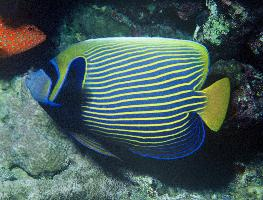
Súlyok és méretek
| Hossz | 40 cm |
|---|
Állatleírás
The Emperor Angelfish, scientifically known as Pomacanthus imperator, is a stunning marine species that captivates the attention of both divers and aquarium enthusiasts around the world. This species belongs to the Pomacanthidae family, which comprises the marine angelfishes. Renowned for its vivid coloration and striking patterns, the Emperor Angelfish is a true jewel of the coral reefs.Adult Emperor Angelfish exhibit a breathtaking palette of colors and patterns. Their bodies are primarily a brilliant blue, adorned with bold, yellow stripes that curve and interlock across their sides, creating a mesmerizing effect. The yellow stripes are edged in a deep, contrasting black, which enhances their visual impact. Their heads feature a dark blue or black mask, which is highlighted by a white or light blue stripe that runs vertically from the top of the snout, across the eyes, and to the top of the head. This distinctive marking adds to their regal appearance, befitting their common name. The tail and the posterior part of the dorsal and anal fins are a vibrant yellow, adding a splash of color that contrasts beautifully with the blue body.
Juvenile Emperor Angelfish present a markedly different appearance, showcasing nature's capacity for dramatic transformations. Their bodies are dark blue to black, densely covered in concentric, circular white to light blue bands. This striking pattern serves as an effective camouflage among the coral reefs, helping to protect the young fish from predators. As they mature, juveniles undergo a remarkable metamorphosis, gradually transitioning to the adult coloration and pattern. This transformation can take several months and is one of the most fascinating aspects of their biology.
Emperor Angelfish are typically found in the warm, tropical waters of the Indian and Pacific Oceans, ranging from the Red Sea and East Africa to the Hawaiian and Pitcairn Islands. They inhabit various types of coral reefs, including lagoons, reef flats, and outer reef slopes, usually at depths ranging from 1 to 100 meters. They are known to be somewhat territorial and are often found alone or in pairs, especially during breeding season.
These angelfish are omnivorous, with a diet that includes both plant and animal matter. In the wild, they feed on a variety of items, including algae, sponges, and small invertebrates. Their feeding habits play a crucial role in the health of coral reef ecosystems, as they help control the growth of algae and sponges.
In terms of behavior, Emperor Angelfish are relatively peaceful but can become territorial, especially towards other angelfish. They are known for their elegance and grace as they glide through the water, a sight that is truly captivating for those lucky enough to observe them in their natural habitat or in a well-maintained aquarium.
Breeding Emperor Angelfish in captivity is a challenging endeavor, primarily due to their specific habitat and dietary requirements. However, successful breeding has been reported, contributing valuable knowledge towards the conservation and understanding of this magnificent species.
The Emperor Angelfish is not only a symbol of the beauty and diversity of marine life but also a reminder of the importance of protecting our oceans and their inhabitants. Through sustainable practices and conservation efforts, we can ensure that future generations will continue to enjoy the wonder of these magnificent creatures.
Új állatfotók
Top 10 állat
- Diana monkey (Cercopithecus diana)
- Dolphin gull (Leucophaeus scoresbii)
- Moustached guenon (Cercopithecus cephus)
- Galápagos tortoise (Geochelone nigra complex)
- Colossal squid (Mesonychoteuthis hamiltoni)
- Japanese spider crab (Macrocheira kaempferi)
- Stone loach (Barbatula barbatula)
- Common house mosquito (Culex pipiens)
- Common reed warbler (Acrocephalus scirpaceus)
- Sea urchins (Echinoidea)